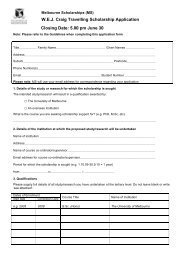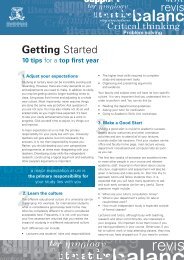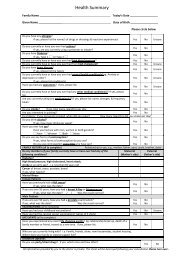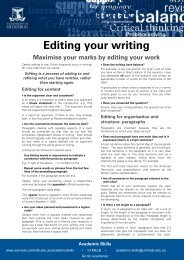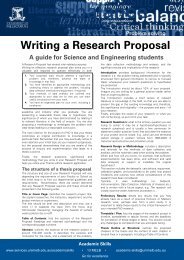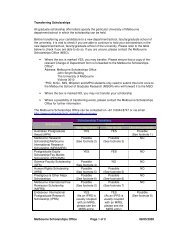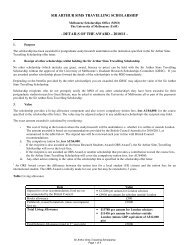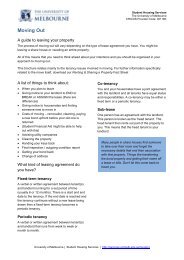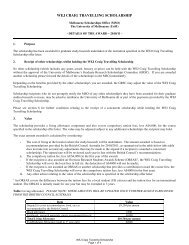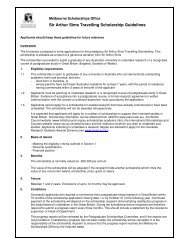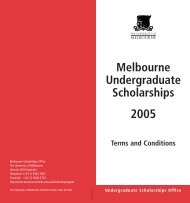Studying in Australia: The Study Abroad Student's Guide to Success
Studying in Australia: The Study Abroad Student's Guide to Success
Studying in Australia: The Study Abroad Student's Guide to Success
You also want an ePaper? Increase the reach of your titles
YUMPU automatically turns print PDFs into web optimized ePapers that Google loves.
Back home <strong>in</strong> all my classesyou’re able <strong>to</strong> get <strong>to</strong> know theprofessor on a first name basis,but here, <strong>in</strong> most of them, I wasjust a face <strong>in</strong> the crowd…Jared, USA<strong>The</strong> <strong>Australia</strong>n Higher Education system is largelya public government funded <strong>in</strong>dustry with only afew private universities.• Universities offer Bachelor degrees <strong>in</strong> manyareas. <strong>The</strong>se are usually 3–4 years <strong>in</strong> length(although some vocational degrees such asmedic<strong>in</strong>e, law and eng<strong>in</strong>eer<strong>in</strong>g may be longer).Double degrees (such as Arts/Law) are alsopopular.• Many discipl<strong>in</strong>es offer an optional Honoursyear for undergraduate students. This additionalyear usually requires advanced coursework anda m<strong>in</strong>or thesis. Master’s and Doc<strong>to</strong>ral degreesare taken either by coursework or research. Bothundergraduate and postgraduate courses areoffered at the same universities.• Universities are divided <strong>in</strong><strong>to</strong> Faculties, such asScience, Arts, Law, etc. Departments/Schoolsare organised with<strong>in</strong> faculties correspond<strong>in</strong>g <strong>to</strong>the discipl<strong>in</strong>es taught (Politics, His<strong>to</strong>ry, Literature,etc.).• <strong>The</strong> <strong>Australia</strong>n university teach<strong>in</strong>g year isusually divided <strong>in</strong><strong>to</strong> two semesters (March – June,and July/August – November). <strong>The</strong>se usually<strong>in</strong>clude 12 weeks of classes, with a short break(non-teach<strong>in</strong>g week) divid<strong>in</strong>g each semester (<strong>in</strong>Semester One, this usually co<strong>in</strong>cides with theEaster break). At the end of each semester thereis a ‘SWOT Vac’ (or study period) and a 2 –3 weekexam<strong>in</strong>ation period. <strong>The</strong>re is usually a four <strong>to</strong> sixweek w<strong>in</strong>ter break between semesters, and athree month summer holiday between years.A new learn<strong>in</strong>g environmentMany students f<strong>in</strong>d study<strong>in</strong>g <strong>in</strong> <strong>Australia</strong> morecasual than <strong>in</strong> their home country. While thelearn<strong>in</strong>g environment may appear casual (forexample, teachers first names are used <strong>in</strong> theclassroom), academics expect respect from theirstudents, and their knowledge and experienceallows them the f<strong>in</strong>al word on the quality of yoursubmitted work.You may hear the term ‘<strong>in</strong>dependent learn<strong>in</strong>g’used <strong>in</strong> reference <strong>to</strong> the <strong>Australia</strong>n highereducation system. This means that you areresponsible for complet<strong>in</strong>g the set read<strong>in</strong>g,undertak<strong>in</strong>g any further research and f<strong>in</strong>ish<strong>in</strong>gany required tasks. It is unlikely that staff willpersonally <strong>in</strong>quire about your progress <strong>in</strong> asubject, or question your non-attendance atclasses or non-submission of work. If you don’task any questions, it will be assumed that youhave no problems. So, it’s all up <strong>to</strong> you <strong>to</strong> keeptrack of your commitments. Independent learn<strong>in</strong>gallows you freedom <strong>in</strong> your study, but also requiresconstant moni<strong>to</strong>r<strong>in</strong>g of your own academicprogress.Lectures, tu<strong>to</strong>rials, labora<strong>to</strong>ries, and practicalclasses are the most typical ways <strong>to</strong> present<strong>in</strong>formation <strong>in</strong> <strong>Australia</strong>n universities. In <strong>Australia</strong>,as <strong>in</strong> your home country, you will experience avariety of teach<strong>in</strong>g styles, methods, format andsize of classes. For example, <strong>in</strong> lectures somestaff will simply ‘lecture’, others will <strong>in</strong>corporatediscussion and small group work. Most lecturerswill use audio-visual aids, such as PowerPo<strong>in</strong>t orPrezi. In some subjects, students run the classes,while the tu<strong>to</strong>r facilitates.<strong>Australia</strong>n Universities<strong>Australia</strong>’s 39 universities <strong>to</strong>gether have an enrolment of more than one million students, andemploy more than 100,000 staff. University expenditure accounts for 1.5% of GDP, with significantspill-over benefits for students, staff, <strong>in</strong>dustry, and the wider community. With 10 Nobel Prizes <strong>to</strong>date, <strong>Australia</strong> is also one of the world’s lead<strong>in</strong>g research nations on a per capita basis. Althoughless than half a per cent of the world’s population, <strong>Australia</strong> accounts for nearly three per cent ofthe world’s research output.Source: Universities <strong>Australia</strong> website [http://www.universitiesaustralia.edu.au/page/australia-s-universities/,accessed 14 Nov 2011]<strong><strong>Study</strong><strong>in</strong>g</strong> <strong>in</strong> <strong>Australia</strong>: <strong>The</strong> <strong>Study</strong> <strong>Abroad</strong> Student’s <strong>Guide</strong> <strong>to</strong> <strong>Success</strong>3



